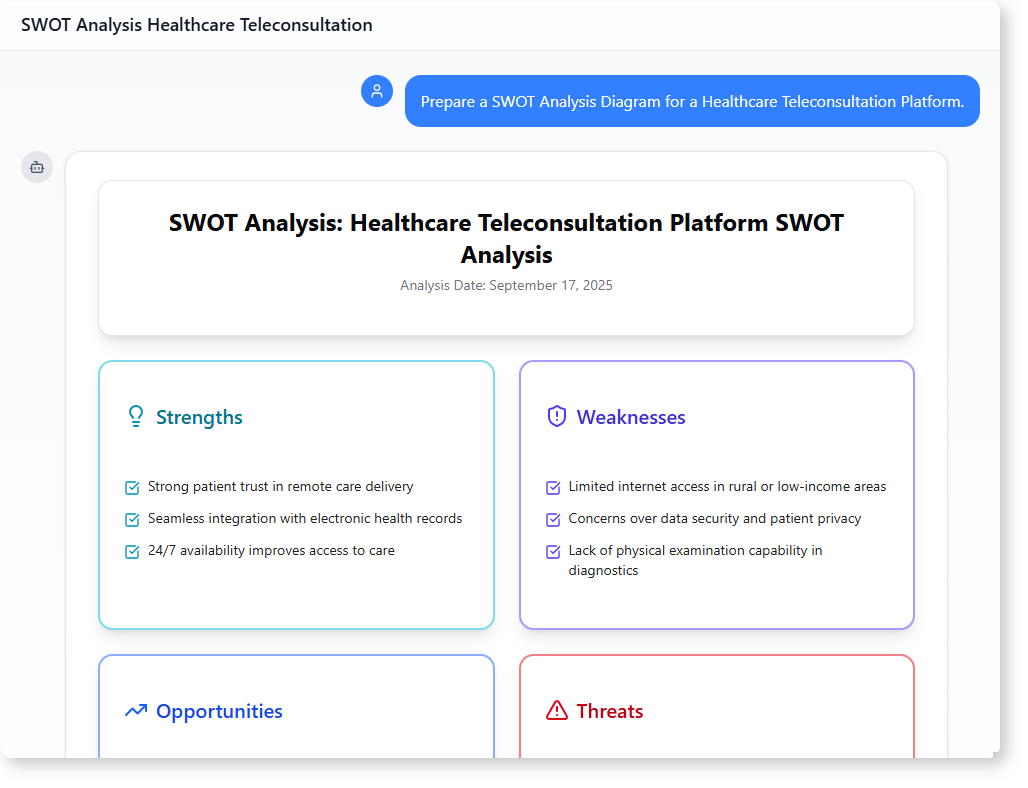Now Reading: How AI-Powered Modeling Software Creates a Smart SWOT Analysis for Healthcare Teleconsultation
-
01
How AI-Powered Modeling Software Creates a Smart SWOT Analysis for Healthcare Teleconsultation
How AI-Powered Modeling Software Creates a Smart SWOT Analysis for Healthcare Teleconsultation
How AI-Powered Modeling Software Builds a Real-World SWOT Analysis
Imagine you’re a healthcare systems analyst tasked with evaluating a new teleconsultation platform. Your job isn’t just to list pros and cons—it’s to understand the big picture: what gives the platform an edge, what risks it faces, and where it can grow.
That’s exactly what happens when someone uses AI-powered modeling software. Instead of spending hours sketching out ideas or manually compiling data, the tool listens to a prompt and generates a well-structured SWOT analysis—complete with clear insights.
This isn’t magic. It’s a smart, reliable workflow built into an AI modeling environment.

A Real-World Use Case: Evaluating a Teleconsultation Platform
The user is part of a digital health initiative aiming to launch a teleconsultation platform. They work in a regional health administration and need to assess the platform’s feasibility before investing in development.
Their challenge? The platform has strong potential, but they’re unsure if it can overcome real-world barriers like internet access or patient trust issues.
So they ask the AI-powered modeling software:
“Prepare a SWOT Analysis Diagram for a Healthcare Teleconsultation Platform.”
The system processes the request and returns a clear, categorized SWOT analysis—organized, factual, and focused on actual market and operational dynamics.
Instead of guessing or relying on incomplete data, the user gains a structured view of the platform’s internal and external factors.
What the AI-Powered Modeling Software Delivers
The tool doesn’t just draw a diagram. It interprets the context and delivers a meaningful breakdown.
Here’s what the generated SWOT analysis reveals:
Strengths
- Strong patient trust in remote care delivery
- Seamless integration with electronic health records
- 24/7 availability improves access to care
These points show the platform’s competitive edge. Patients see value in convenience and continuity of care, especially in underserved areas.
Weaknesses
- Limited internet access in rural or low-income areas
- Concerns over data security and patient privacy
- Lack of physical examination capability in diagnostics
These weaknesses highlight real-world limitations. The absence of physical exams means the platform can’t replace traditional doctor visits for certain conditions. Data privacy remains a sensitive issue that requires careful design.
Opportunities
- Increasing demand for virtual primary care
- Expansion into mental health and chronic disease management
- Partnerships with insurance providers for reimbursement
This section shows where the platform can grow. As patients increasingly prefer remote care, the model aligns with long-term healthcare shifts. Expanding into mental health could open new revenue streams.
Threats
- Regulatory challenges in telehealth reimbursement
- Rising competition from established health platforms
- Potential legal liability in misdiagnoses via remote tools
These threats are critical. The platform must navigate complex medical regulations and compete with well-funded, established services. Misdiagnosis risks, though rare, could damage trust and lead to legal consequences.
Why This Matters for Decision-Makers
This isn’t just a list of points. It’s a foundation for strategic planning.
For example:
- The strength in EHR integration suggests a path to quick adoption by clinics.
- The weakness in physical exams shows that diagnostic limitations must be clearly communicated to patients.
- The opportunity to expand into mental health is a clear direction the platform should explore.
The AI-powered modeling software doesn’t offer opinions. It provides a factual, data-informed snapshot of the situation—something that could take days to compile manually.
How It Fits Into Modern Healthcare Planning
Healthcare leaders face complex decisions every day. Whether it’s launching a new service or evaluating an existing one, clarity in risk and opportunity is essential.
This use case shows how AI modeling tools help move beyond vague assumptions. With a single prompt, the tool produces a structured, insightful SWOT diagram—something that can be immediately shared with stakeholders, used in planning meetings, or fed into further research.
It’s not a replacement for human judgment. But it serves as a valuable starting point—an objective lens to examine what’s working, what’s not, and where growth could happen.
Frequently Asked Questions
What makes AI-powered modeling software different from traditional SWOT tools?
Traditional SWOT tools require manual input and effort to organize lists. AI-powered modeling software uses context-aware intelligence to generate accurate, relevant, and balanced analyses based on the scenario provided.
Can this approach be used for other healthcare platforms?
Yes. The same AI-powered modeling software can generate SWOT analyses for telemedicine, mental health apps, chronic care management systems, or even teleconsultation in rural settings.
Is the AI output based on real-world data?
Not exactly. The output is built from logical inferences and domain knowledge derived from healthcare trends and common platform challenges. It reflects realistic scenarios, not raw data.
How can this help in planning a new digital health service?
By identifying key strengths, weaknesses, opportunities, and threats early, teams can design better solutions, avoid blind spots, and build trust with patients and providers.
Ready to map out your system’s future with clarity? Give our AI-powered modeling software a try at Visual Paradigm’s AI Chatbot today!
